Griffith University Corporations Law: Corporate Veil Doctrine Analysis
VerifiedAdded on 2022/10/01
|14
|3792
|249
Essay
AI Summary
This essay critically analyzes the doctrine of corporate veil within the framework of corporations law. It begins by establishing the concept of a company as a separate legal entity, distinct from its owners and managers, and the benefits this structure provides, including limited liability. The essay explores the principle of the corporate veil, which shields owners and managers from company liabilities, and discusses instances where courts may lift this veil. The analysis includes key cases such as Salomon v A Salomon & Co Ltd, DHN Food Distributors v Tower Hamlets, Adams v Cape Industries plc, Smith, Stone & Knight Ltd V. Birmingham Group, Green v Bestobell Industries Pty Ltd, Gilford Motor Co Ltd v Horne, and Creasey v Breachwood Motors Ltd to illustrate scenarios where the veil may be pierced due to misuse of power, breaches of fiduciary duty, or attempts to evade pre-existing liabilities. The essay also touches upon the agency theory and its relevance to corporate governance and director's responsibilities. Overall, the essay provides a comprehensive overview of the doctrine, its practical implications, and the circumstances under which it is subject to judicial scrutiny.
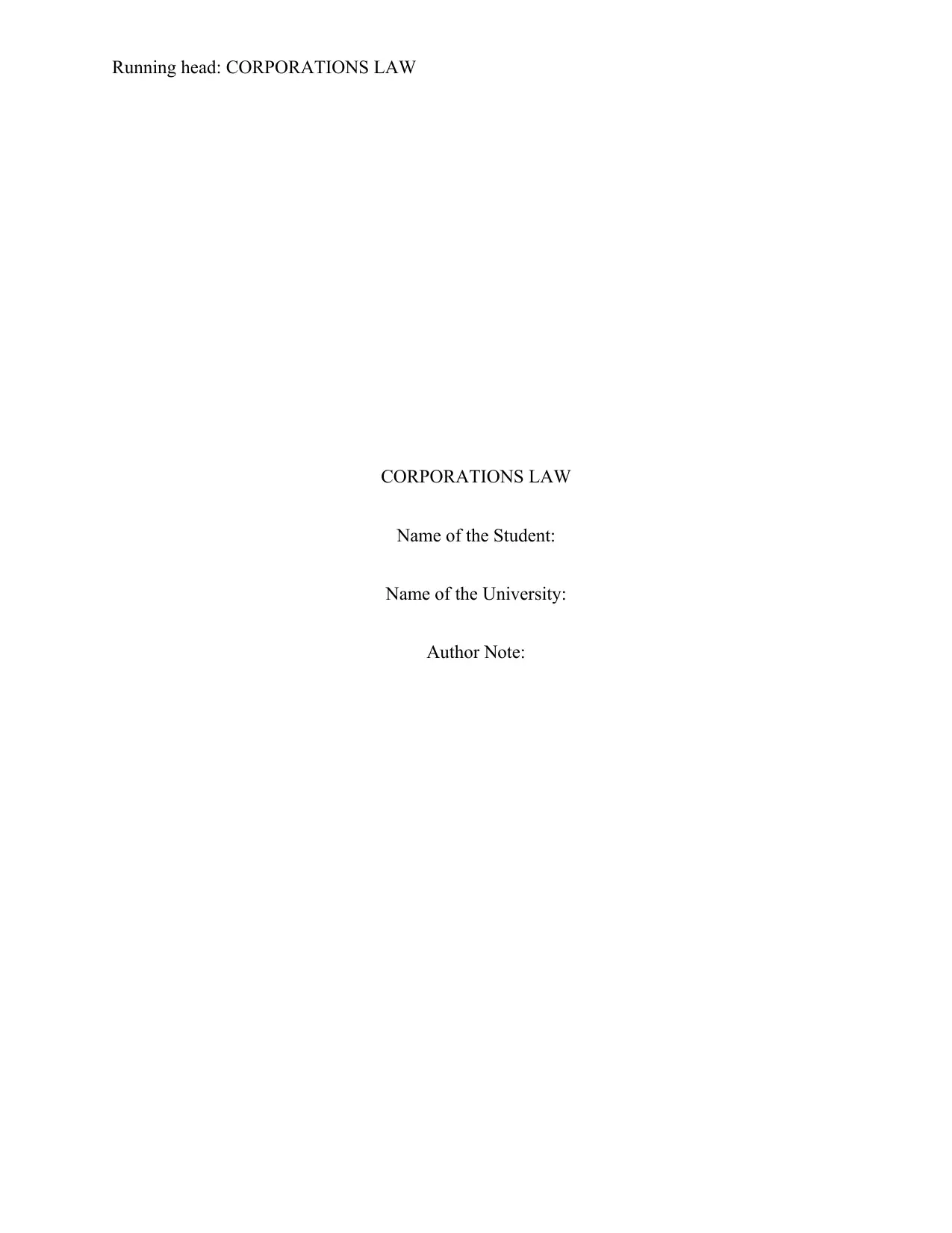
Running head: CORPORATIONS LAW
CORPORATIONS LAW
Name of the Student:
Name of the University:
Author Note:
CORPORATIONS LAW
Name of the Student:
Name of the University:
Author Note:
Paraphrase This Document
Need a fresh take? Get an instant paraphrase of this document with our AI Paraphraser
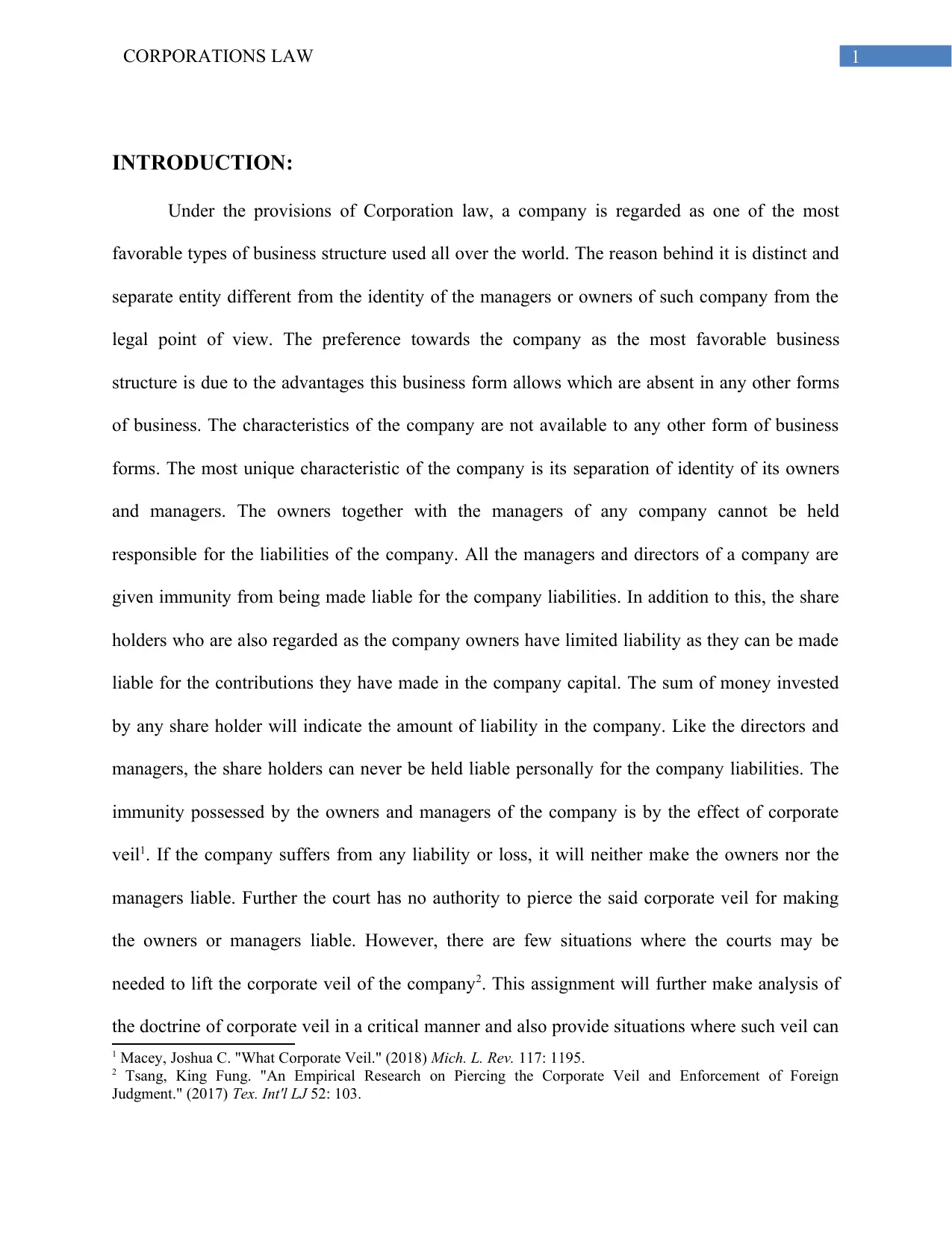
1CORPORATIONS LAW
INTRODUCTION:
Under the provisions of Corporation law, a company is regarded as one of the most
favorable types of business structure used all over the world. The reason behind it is distinct and
separate entity different from the identity of the managers or owners of such company from the
legal point of view. The preference towards the company as the most favorable business
structure is due to the advantages this business form allows which are absent in any other forms
of business. The characteristics of the company are not available to any other form of business
forms. The most unique characteristic of the company is its separation of identity of its owners
and managers. The owners together with the managers of any company cannot be held
responsible for the liabilities of the company. All the managers and directors of a company are
given immunity from being made liable for the company liabilities. In addition to this, the share
holders who are also regarded as the company owners have limited liability as they can be made
liable for the contributions they have made in the company capital. The sum of money invested
by any share holder will indicate the amount of liability in the company. Like the directors and
managers, the share holders can never be held liable personally for the company liabilities. The
immunity possessed by the owners and managers of the company is by the effect of corporate
veil1. If the company suffers from any liability or loss, it will neither make the owners nor the
managers liable. Further the court has no authority to pierce the said corporate veil for making
the owners or managers liable. However, there are few situations where the courts may be
needed to lift the corporate veil of the company2. This assignment will further make analysis of
the doctrine of corporate veil in a critical manner and also provide situations where such veil can
1 Macey, Joshua C. "What Corporate Veil." (2018) Mich. L. Rev. 117: 1195.
2 Tsang, King Fung. "An Empirical Research on Piercing the Corporate Veil and Enforcement of Foreign
Judgment." (2017) Tex. Int'l LJ 52: 103.
INTRODUCTION:
Under the provisions of Corporation law, a company is regarded as one of the most
favorable types of business structure used all over the world. The reason behind it is distinct and
separate entity different from the identity of the managers or owners of such company from the
legal point of view. The preference towards the company as the most favorable business
structure is due to the advantages this business form allows which are absent in any other forms
of business. The characteristics of the company are not available to any other form of business
forms. The most unique characteristic of the company is its separation of identity of its owners
and managers. The owners together with the managers of any company cannot be held
responsible for the liabilities of the company. All the managers and directors of a company are
given immunity from being made liable for the company liabilities. In addition to this, the share
holders who are also regarded as the company owners have limited liability as they can be made
liable for the contributions they have made in the company capital. The sum of money invested
by any share holder will indicate the amount of liability in the company. Like the directors and
managers, the share holders can never be held liable personally for the company liabilities. The
immunity possessed by the owners and managers of the company is by the effect of corporate
veil1. If the company suffers from any liability or loss, it will neither make the owners nor the
managers liable. Further the court has no authority to pierce the said corporate veil for making
the owners or managers liable. However, there are few situations where the courts may be
needed to lift the corporate veil of the company2. This assignment will further make analysis of
the doctrine of corporate veil in a critical manner and also provide situations where such veil can
1 Macey, Joshua C. "What Corporate Veil." (2018) Mich. L. Rev. 117: 1195.
2 Tsang, King Fung. "An Empirical Research on Piercing the Corporate Veil and Enforcement of Foreign
Judgment." (2017) Tex. Int'l LJ 52: 103.
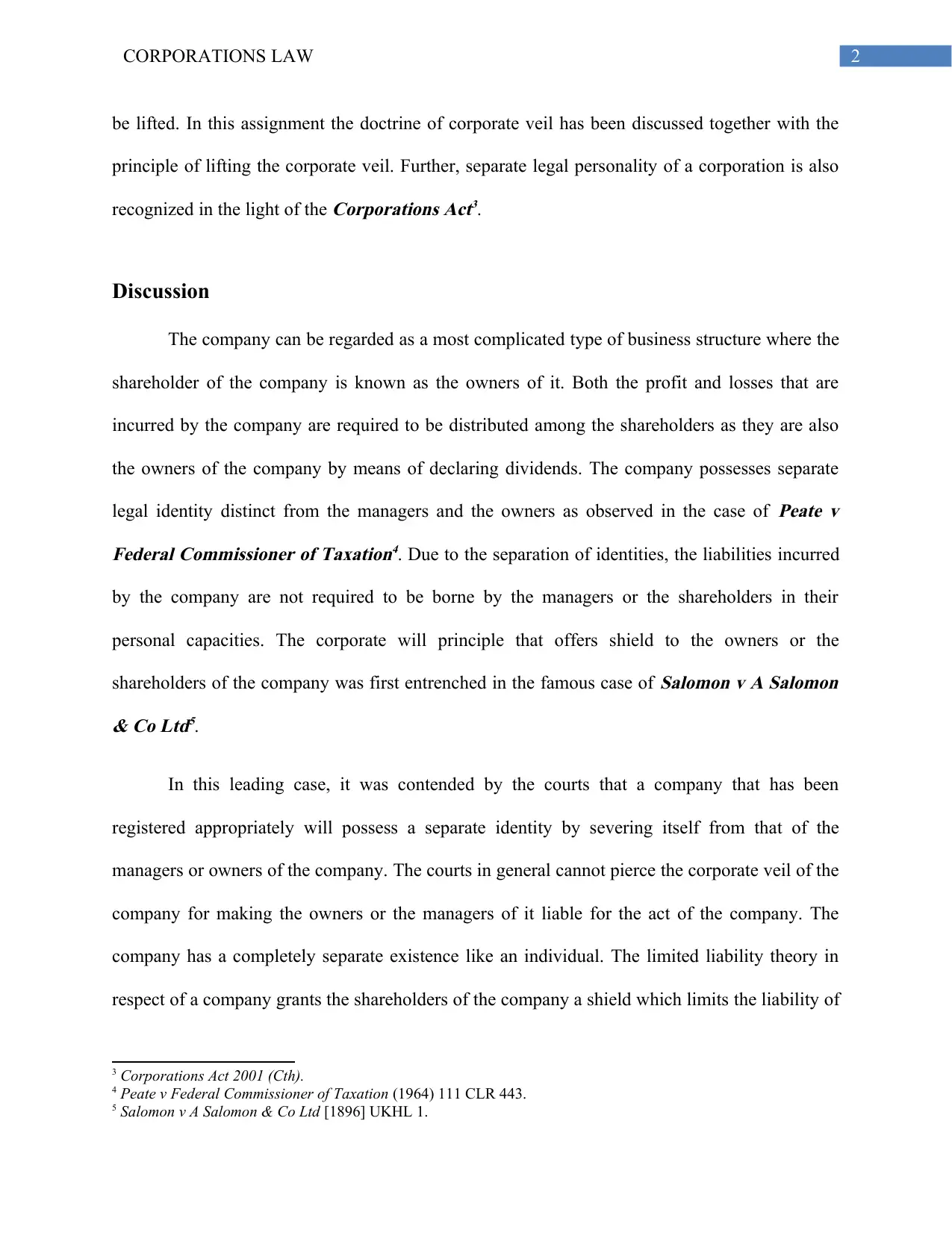
2CORPORATIONS LAW
be lifted. In this assignment the doctrine of corporate veil has been discussed together with the
principle of lifting the corporate veil. Further, separate legal personality of a corporation is also
recognized in the light of the
Corporations Act3.
Discussion
The company can be regarded as a most complicated type of business structure where the
shareholder of the company is known as the owners of it. Both the profit and losses that are
incurred by the company are required to be distributed among the shareholders as they are also
the owners of the company by means of declaring dividends. The company possesses separate
legal identity distinct from the managers and the owners as observed in the case of
Peate v
Federal Commissioner of Taxation4. Due to the separation of identities, the liabilities incurred
by the company are not required to be borne by the managers or the shareholders in their
personal capacities. The corporate will principle that offers shield to the owners or the
shareholders of the company was first entrenched in the famous case of
Salomon v A Salomon
& Co Ltd5.
In this leading case, it was contended by the courts that a company that has been
registered appropriately will possess a separate identity by severing itself from that of the
managers or owners of the company. The courts in general cannot pierce the corporate veil of the
company for making the owners or the managers of it liable for the act of the company. The
company has a completely separate existence like an individual. The limited liability theory in
respect of a company grants the shareholders of the company a shield which limits the liability of
3 Corporations Act 2001 (Cth).
4 Peate v Federal Commissioner of Taxation (1964) 111 CLR 443.
5 Salomon v A Salomon & Co Ltd [1896] UKHL 1.
be lifted. In this assignment the doctrine of corporate veil has been discussed together with the
principle of lifting the corporate veil. Further, separate legal personality of a corporation is also
recognized in the light of the
Corporations Act3.
Discussion
The company can be regarded as a most complicated type of business structure where the
shareholder of the company is known as the owners of it. Both the profit and losses that are
incurred by the company are required to be distributed among the shareholders as they are also
the owners of the company by means of declaring dividends. The company possesses separate
legal identity distinct from the managers and the owners as observed in the case of
Peate v
Federal Commissioner of Taxation4. Due to the separation of identities, the liabilities incurred
by the company are not required to be borne by the managers or the shareholders in their
personal capacities. The corporate will principle that offers shield to the owners or the
shareholders of the company was first entrenched in the famous case of
Salomon v A Salomon
& Co Ltd5.
In this leading case, it was contended by the courts that a company that has been
registered appropriately will possess a separate identity by severing itself from that of the
managers or owners of the company. The courts in general cannot pierce the corporate veil of the
company for making the owners or the managers of it liable for the act of the company. The
company has a completely separate existence like an individual. The limited liability theory in
respect of a company grants the shareholders of the company a shield which limits the liability of
3 Corporations Act 2001 (Cth).
4 Peate v Federal Commissioner of Taxation (1964) 111 CLR 443.
5 Salomon v A Salomon & Co Ltd [1896] UKHL 1.
⊘ This is a preview!⊘
Do you want full access?
Subscribe today to unlock all pages.

Trusted by 1+ million students worldwide
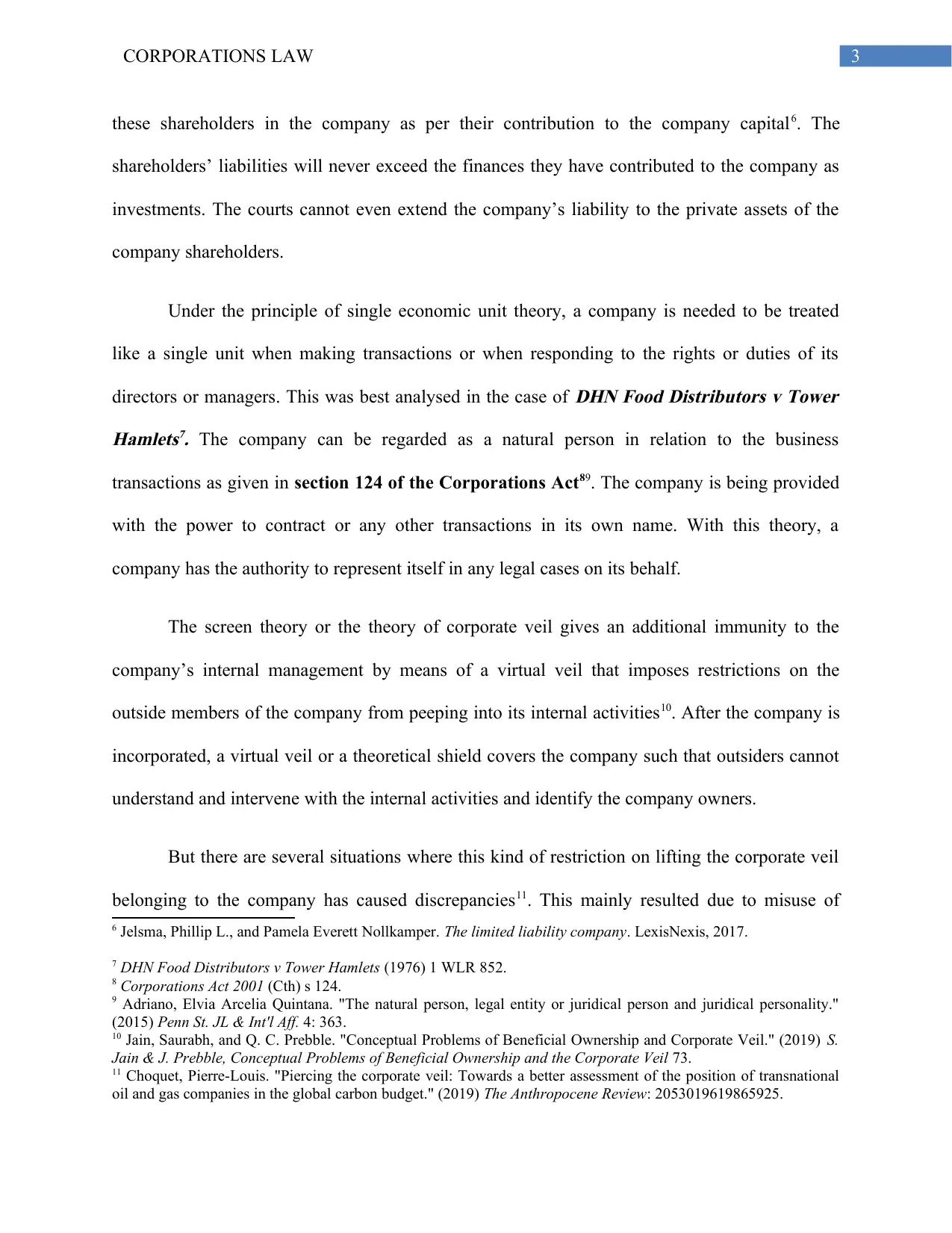
3CORPORATIONS LAW
these shareholders in the company as per their contribution to the company capital6. The
shareholders’ liabilities will never exceed the finances they have contributed to the company as
investments. The courts cannot even extend the company’s liability to the private assets of the
company shareholders.
Under the principle of single economic unit theory, a company is needed to be treated
like a single unit when making transactions or when responding to the rights or duties of its
directors or managers. This was best analysed in the case of
DHN Food Distributors v Tower
Hamlets7. The company can be regarded as a natural person in relation to the business
transactions as given in section 124 of the Corporations Act89. The company is being provided
with the power to contract or any other transactions in its own name. With this theory, a
company has the authority to represent itself in any legal cases on its behalf.
The screen theory or the theory of corporate veil gives an additional immunity to the
company’s internal management by means of a virtual veil that imposes restrictions on the
outside members of the company from peeping into its internal activities10. After the company is
incorporated, a virtual veil or a theoretical shield covers the company such that outsiders cannot
understand and intervene with the internal activities and identify the company owners.
But there are several situations where this kind of restriction on lifting the corporate veil
belonging to the company has caused discrepancies11. This mainly resulted due to misuse of
6 Jelsma, Phillip L., and Pamela Everett Nollkamper. The limited liability company. LexisNexis, 2017.
7 DHN Food Distributors v Tower Hamlets (1976) 1 WLR 852.
8 Corporations Act 2001 (Cth) s 124.
9 Adriano, Elvia Arcelia Quintana. "The natural person, legal entity or juridical person and juridical personality."
(2015) Penn St. JL & Int'l Aff. 4: 363.
10 Jain, Saurabh, and Q. C. Prebble. "Conceptual Problems of Beneficial Ownership and Corporate Veil." (2019) S.
Jain & J. Prebble, Conceptual Problems of Beneficial Ownership and the Corporate Veil 73.
11 Choquet, Pierre-Louis. "Piercing the corporate veil: Towards a better assessment of the position of transnational
oil and gas companies in the global carbon budget." (2019) The Anthropocene Review: 2053019619865925.
these shareholders in the company as per their contribution to the company capital6. The
shareholders’ liabilities will never exceed the finances they have contributed to the company as
investments. The courts cannot even extend the company’s liability to the private assets of the
company shareholders.
Under the principle of single economic unit theory, a company is needed to be treated
like a single unit when making transactions or when responding to the rights or duties of its
directors or managers. This was best analysed in the case of
DHN Food Distributors v Tower
Hamlets7. The company can be regarded as a natural person in relation to the business
transactions as given in section 124 of the Corporations Act89. The company is being provided
with the power to contract or any other transactions in its own name. With this theory, a
company has the authority to represent itself in any legal cases on its behalf.
The screen theory or the theory of corporate veil gives an additional immunity to the
company’s internal management by means of a virtual veil that imposes restrictions on the
outside members of the company from peeping into its internal activities10. After the company is
incorporated, a virtual veil or a theoretical shield covers the company such that outsiders cannot
understand and intervene with the internal activities and identify the company owners.
But there are several situations where this kind of restriction on lifting the corporate veil
belonging to the company has caused discrepancies11. This mainly resulted due to misuse of
6 Jelsma, Phillip L., and Pamela Everett Nollkamper. The limited liability company. LexisNexis, 2017.
7 DHN Food Distributors v Tower Hamlets (1976) 1 WLR 852.
8 Corporations Act 2001 (Cth) s 124.
9 Adriano, Elvia Arcelia Quintana. "The natural person, legal entity or juridical person and juridical personality."
(2015) Penn St. JL & Int'l Aff. 4: 363.
10 Jain, Saurabh, and Q. C. Prebble. "Conceptual Problems of Beneficial Ownership and Corporate Veil." (2019) S.
Jain & J. Prebble, Conceptual Problems of Beneficial Ownership and the Corporate Veil 73.
11 Choquet, Pierre-Louis. "Piercing the corporate veil: Towards a better assessment of the position of transnational
oil and gas companies in the global carbon budget." (2019) The Anthropocene Review: 2053019619865925.
Paraphrase This Document
Need a fresh take? Get an instant paraphrase of this document with our AI Paraphraser
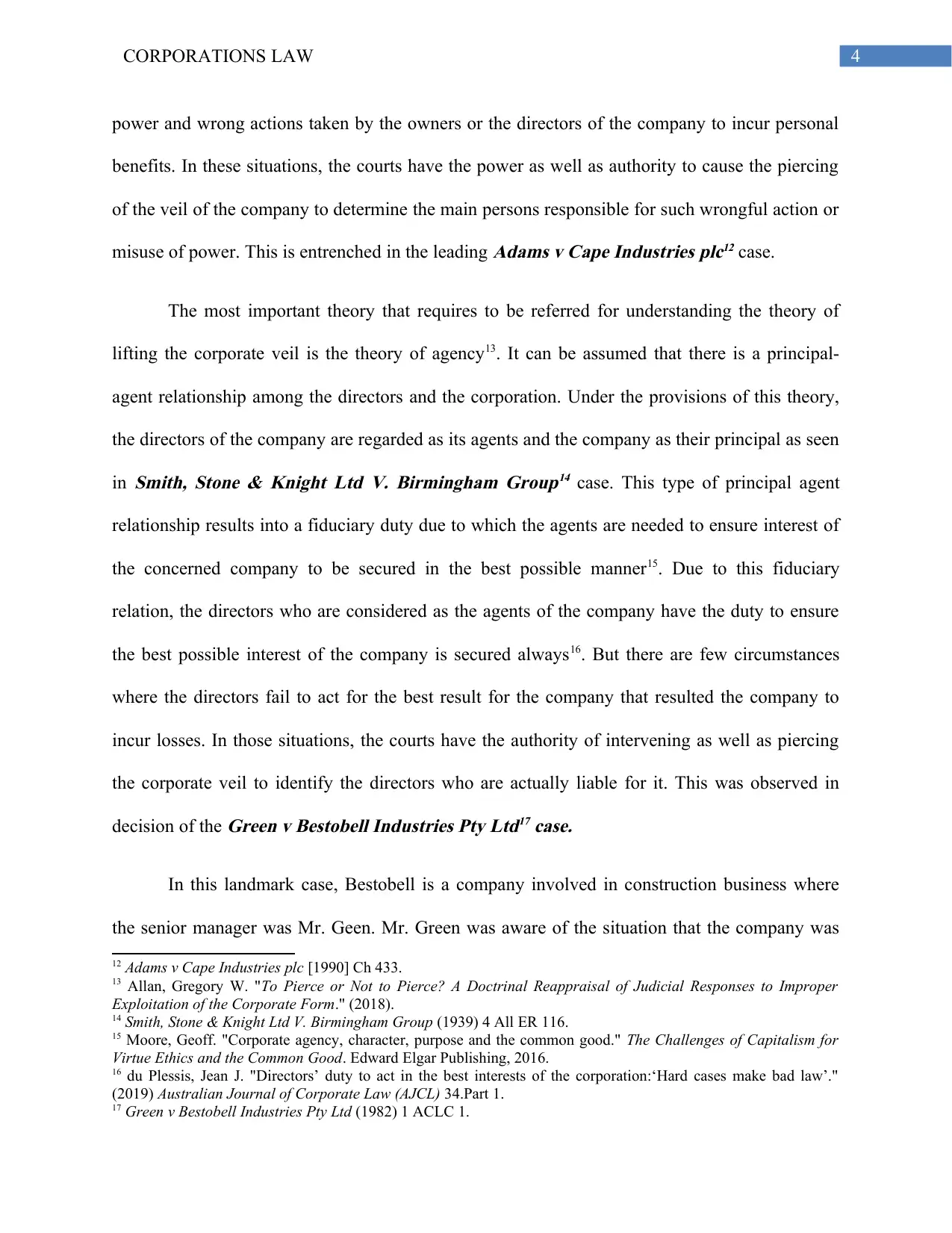
4CORPORATIONS LAW
power and wrong actions taken by the owners or the directors of the company to incur personal
benefits. In these situations, the courts have the power as well as authority to cause the piercing
of the veil of the company to determine the main persons responsible for such wrongful action or
misuse of power. This is entrenched in the leading
Adams v Cape Industries plc12 case.
The most important theory that requires to be referred for understanding the theory of
lifting the corporate veil is the theory of agency13. It can be assumed that there is a principal-
agent relationship among the directors and the corporation. Under the provisions of this theory,
the directors of the company are regarded as its agents and the company as their principal as seen
in
Smith, Stone & Knight Ltd V. Birmingham Group14 case. This type of principal agent
relationship results into a fiduciary duty due to which the agents are needed to ensure interest of
the concerned company to be secured in the best possible manner15. Due to this fiduciary
relation, the directors who are considered as the agents of the company have the duty to ensure
the best possible interest of the company is secured always16. But there are few circumstances
where the directors fail to act for the best result for the company that resulted the company to
incur losses. In those situations, the courts have the authority of intervening as well as piercing
the corporate veil to identify the directors who are actually liable for it. This was observed in
decision of the
Green v Bestobell Industries Pty Ltd17 case.
In this landmark case, Bestobell is a company involved in construction business where
the senior manager was Mr. Geen. Mr. Green was aware of the situation that the company was
12 Adams v Cape Industries plc [1990] Ch 433.
13 Allan, Gregory W. "To Pierce or Not to Pierce? A Doctrinal Reappraisal of Judicial Responses to Improper
Exploitation of the Corporate Form." (2018).
14 Smith, Stone & Knight Ltd V. Birmingham Group (1939) 4 All ER 116.
15 Moore, Geoff. "Corporate agency, character, purpose and the common good." The Challenges of Capitalism for
Virtue Ethics and the Common Good. Edward Elgar Publishing, 2016.
16 du Plessis, Jean J. "Directors’ duty to act in the best interests of the corporation:‘Hard cases make bad law’."
(2019) Australian Journal of Corporate Law (AJCL) 34.Part 1.
17 Green v Bestobell Industries Pty Ltd (1982) 1 ACLC 1.
power and wrong actions taken by the owners or the directors of the company to incur personal
benefits. In these situations, the courts have the power as well as authority to cause the piercing
of the veil of the company to determine the main persons responsible for such wrongful action or
misuse of power. This is entrenched in the leading
Adams v Cape Industries plc12 case.
The most important theory that requires to be referred for understanding the theory of
lifting the corporate veil is the theory of agency13. It can be assumed that there is a principal-
agent relationship among the directors and the corporation. Under the provisions of this theory,
the directors of the company are regarded as its agents and the company as their principal as seen
in
Smith, Stone & Knight Ltd V. Birmingham Group14 case. This type of principal agent
relationship results into a fiduciary duty due to which the agents are needed to ensure interest of
the concerned company to be secured in the best possible manner15. Due to this fiduciary
relation, the directors who are considered as the agents of the company have the duty to ensure
the best possible interest of the company is secured always16. But there are few circumstances
where the directors fail to act for the best result for the company that resulted the company to
incur losses. In those situations, the courts have the authority of intervening as well as piercing
the corporate veil to identify the directors who are actually liable for it. This was observed in
decision of the
Green v Bestobell Industries Pty Ltd17 case.
In this landmark case, Bestobell is a company involved in construction business where
the senior manager was Mr. Geen. Mr. Green was aware of the situation that the company was
12 Adams v Cape Industries plc [1990] Ch 433.
13 Allan, Gregory W. "To Pierce or Not to Pierce? A Doctrinal Reappraisal of Judicial Responses to Improper
Exploitation of the Corporate Form." (2018).
14 Smith, Stone & Knight Ltd V. Birmingham Group (1939) 4 All ER 116.
15 Moore, Geoff. "Corporate agency, character, purpose and the common good." The Challenges of Capitalism for
Virtue Ethics and the Common Good. Edward Elgar Publishing, 2016.
16 du Plessis, Jean J. "Directors’ duty to act in the best interests of the corporation:‘Hard cases make bad law’."
(2019) Australian Journal of Corporate Law (AJCL) 34.Part 1.
17 Green v Bestobell Industries Pty Ltd (1982) 1 ACLC 1.
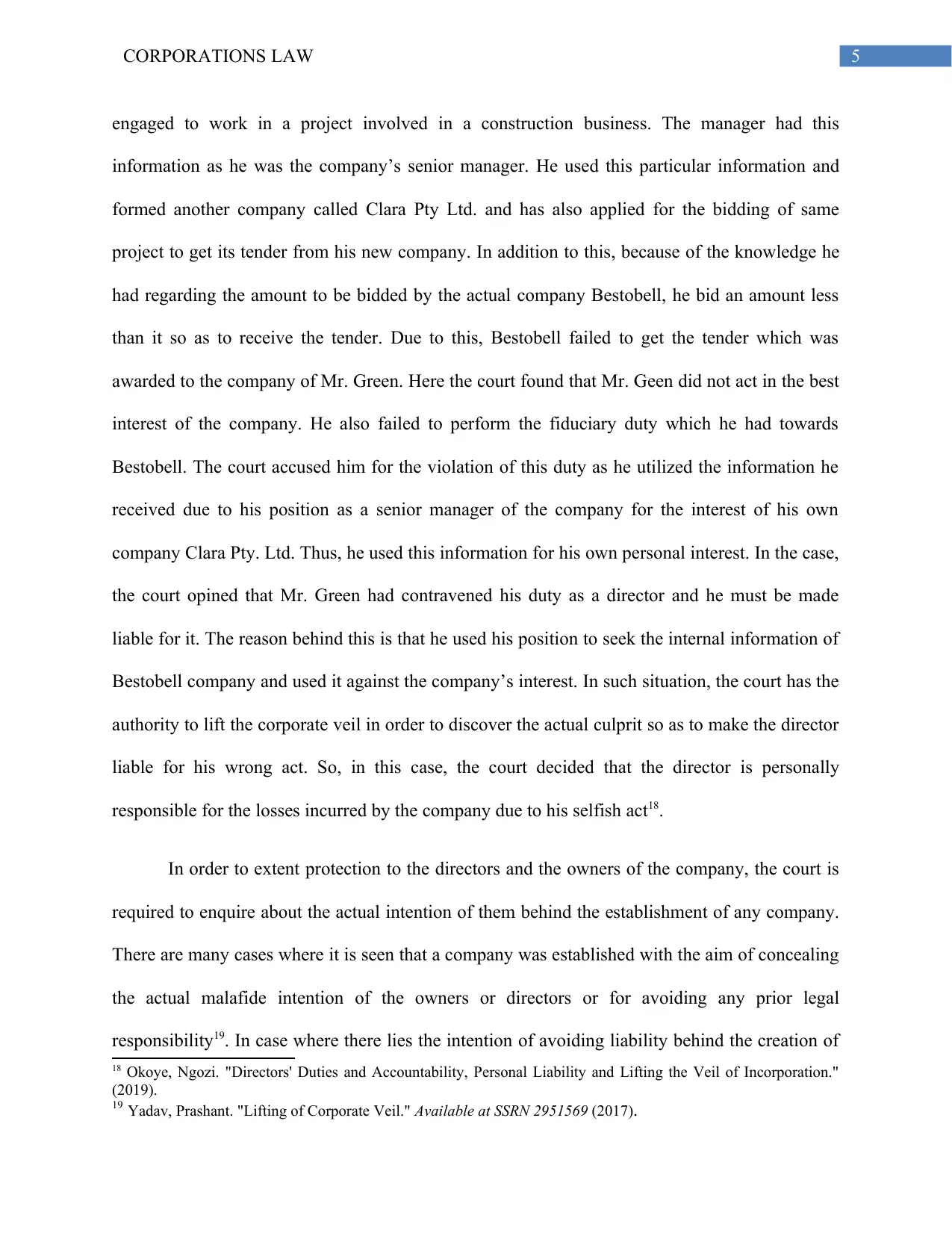
5CORPORATIONS LAW
engaged to work in a project involved in a construction business. The manager had this
information as he was the company’s senior manager. He used this particular information and
formed another company called Clara Pty Ltd. and has also applied for the bidding of same
project to get its tender from his new company. In addition to this, because of the knowledge he
had regarding the amount to be bidded by the actual company Bestobell, he bid an amount less
than it so as to receive the tender. Due to this, Bestobell failed to get the tender which was
awarded to the company of Mr. Green. Here the court found that Mr. Geen did not act in the best
interest of the company. He also failed to perform the fiduciary duty which he had towards
Bestobell. The court accused him for the violation of this duty as he utilized the information he
received due to his position as a senior manager of the company for the interest of his own
company Clara Pty. Ltd. Thus, he used this information for his own personal interest. In the case,
the court opined that Mr. Green had contravened his duty as a director and he must be made
liable for it. The reason behind this is that he used his position to seek the internal information of
Bestobell company and used it against the company’s interest. In such situation, the court has the
authority to lift the corporate veil in order to discover the actual culprit so as to make the director
liable for his wrong act. So, in this case, the court decided that the director is personally
responsible for the losses incurred by the company due to his selfish act18.
In order to extent protection to the directors and the owners of the company, the court is
required to enquire about the actual intention of them behind the establishment of any company.
There are many cases where it is seen that a company was established with the aim of concealing
the actual malafide intention of the owners or directors or for avoiding any prior legal
responsibility19. In case where there lies the intention of avoiding liability behind the creation of
18 Okoye, Ngozi. "Directors' Duties and Accountability, Personal Liability and Lifting the Veil of Incorporation."
(2019).
19 Yadav, Prashant. "Lifting of Corporate Veil." Available at SSRN 2951569 (2017).
engaged to work in a project involved in a construction business. The manager had this
information as he was the company’s senior manager. He used this particular information and
formed another company called Clara Pty Ltd. and has also applied for the bidding of same
project to get its tender from his new company. In addition to this, because of the knowledge he
had regarding the amount to be bidded by the actual company Bestobell, he bid an amount less
than it so as to receive the tender. Due to this, Bestobell failed to get the tender which was
awarded to the company of Mr. Green. Here the court found that Mr. Geen did not act in the best
interest of the company. He also failed to perform the fiduciary duty which he had towards
Bestobell. The court accused him for the violation of this duty as he utilized the information he
received due to his position as a senior manager of the company for the interest of his own
company Clara Pty. Ltd. Thus, he used this information for his own personal interest. In the case,
the court opined that Mr. Green had contravened his duty as a director and he must be made
liable for it. The reason behind this is that he used his position to seek the internal information of
Bestobell company and used it against the company’s interest. In such situation, the court has the
authority to lift the corporate veil in order to discover the actual culprit so as to make the director
liable for his wrong act. So, in this case, the court decided that the director is personally
responsible for the losses incurred by the company due to his selfish act18.
In order to extent protection to the directors and the owners of the company, the court is
required to enquire about the actual intention of them behind the establishment of any company.
There are many cases where it is seen that a company was established with the aim of concealing
the actual malafide intention of the owners or directors or for avoiding any prior legal
responsibility19. In case where there lies the intention of avoiding liability behind the creation of
18 Okoye, Ngozi. "Directors' Duties and Accountability, Personal Liability and Lifting the Veil of Incorporation."
(2019).
19 Yadav, Prashant. "Lifting of Corporate Veil." Available at SSRN 2951569 (2017).
⊘ This is a preview!⊘
Do you want full access?
Subscribe today to unlock all pages.

Trusted by 1+ million students worldwide
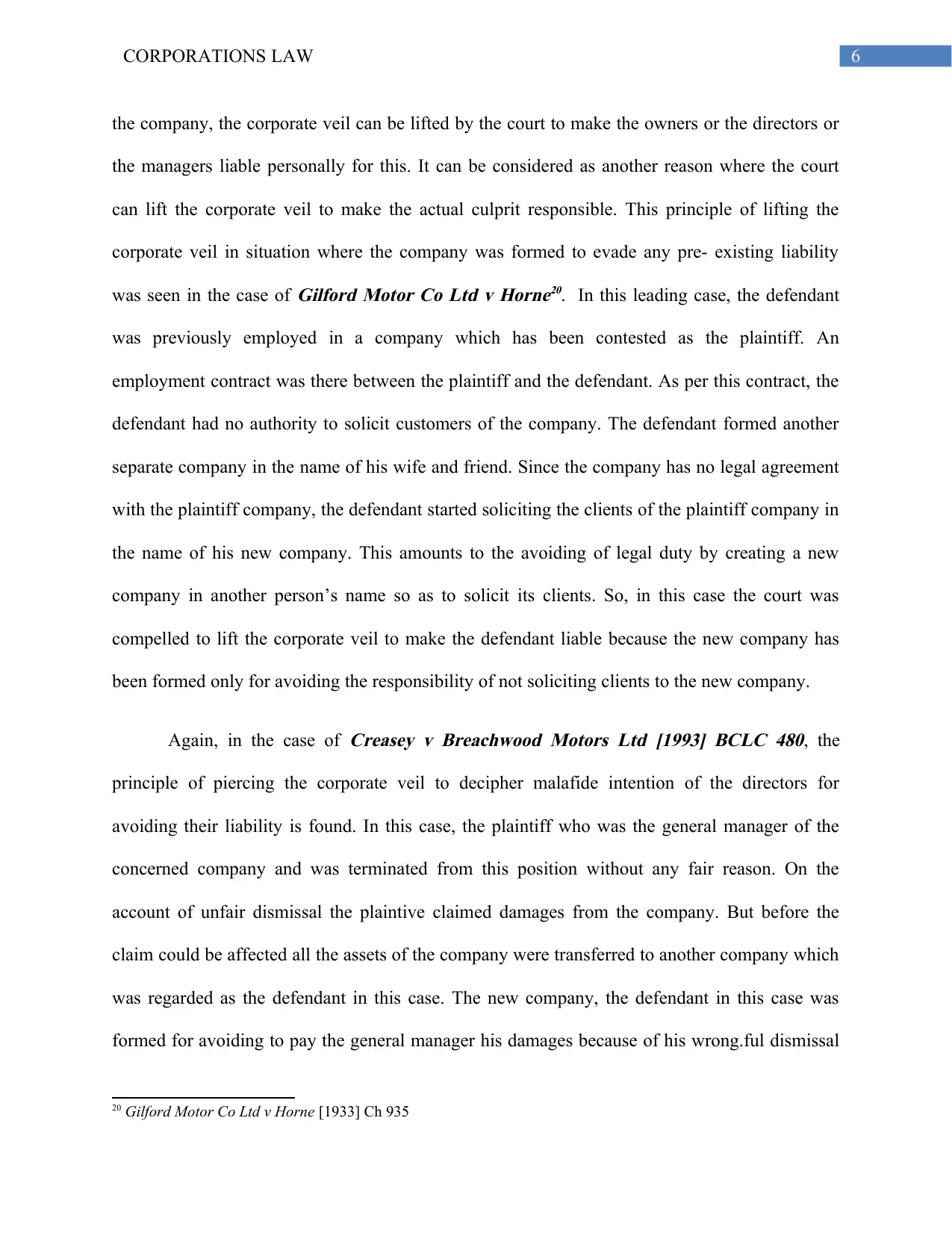
6CORPORATIONS LAW
the company, the corporate veil can be lifted by the court to make the owners or the directors or
the managers liable personally for this. It can be considered as another reason where the court
can lift the corporate veil to make the actual culprit responsible. This principle of lifting the
corporate veil in situation where the company was formed to evade any pre- existing liability
was seen in the case of
Gilford Motor Co Ltd v Horne20. In this leading case, the defendant
was previously employed in a company which has been contested as the plaintiff. An
employment contract was there between the plaintiff and the defendant. As per this contract, the
defendant had no authority to solicit customers of the company. The defendant formed another
separate company in the name of his wife and friend. Since the company has no legal agreement
with the plaintiff company, the defendant started soliciting the clients of the plaintiff company in
the name of his new company. This amounts to the avoiding of legal duty by creating a new
company in another person’s name so as to solicit its clients. So, in this case the court was
compelled to lift the corporate veil to make the defendant liable because the new company has
been formed only for avoiding the responsibility of not soliciting clients to the new company.
Again, in the case of
Creasey v Breachwood Motors Ltd [1993] BCLC 480, the
principle of piercing the corporate veil to decipher malafide intention of the directors for
avoiding their liability is found. In this case, the plaintiff who was the general manager of the
concerned company and was terminated from this position without any fair reason. On the
account of unfair dismissal the plaintive claimed damages from the company. But before the
claim could be affected all the assets of the company were transferred to another company which
was regarded as the defendant in this case. The new company, the defendant in this case was
formed for avoiding to pay the general manager his damages because of his wrong.ful dismissal
20 Gilford Motor Co Ltd v Horne [1933] Ch 935
the company, the corporate veil can be lifted by the court to make the owners or the directors or
the managers liable personally for this. It can be considered as another reason where the court
can lift the corporate veil to make the actual culprit responsible. This principle of lifting the
corporate veil in situation where the company was formed to evade any pre- existing liability
was seen in the case of
Gilford Motor Co Ltd v Horne20. In this leading case, the defendant
was previously employed in a company which has been contested as the plaintiff. An
employment contract was there between the plaintiff and the defendant. As per this contract, the
defendant had no authority to solicit customers of the company. The defendant formed another
separate company in the name of his wife and friend. Since the company has no legal agreement
with the plaintiff company, the defendant started soliciting the clients of the plaintiff company in
the name of his new company. This amounts to the avoiding of legal duty by creating a new
company in another person’s name so as to solicit its clients. So, in this case the court was
compelled to lift the corporate veil to make the defendant liable because the new company has
been formed only for avoiding the responsibility of not soliciting clients to the new company.
Again, in the case of
Creasey v Breachwood Motors Ltd [1993] BCLC 480, the
principle of piercing the corporate veil to decipher malafide intention of the directors for
avoiding their liability is found. In this case, the plaintiff who was the general manager of the
concerned company and was terminated from this position without any fair reason. On the
account of unfair dismissal the plaintive claimed damages from the company. But before the
claim could be affected all the assets of the company were transferred to another company which
was regarded as the defendant in this case. The new company, the defendant in this case was
formed for avoiding to pay the general manager his damages because of his wrong.ful dismissal
20 Gilford Motor Co Ltd v Horne [1933] Ch 935
Paraphrase This Document
Need a fresh take? Get an instant paraphrase of this document with our AI Paraphraser
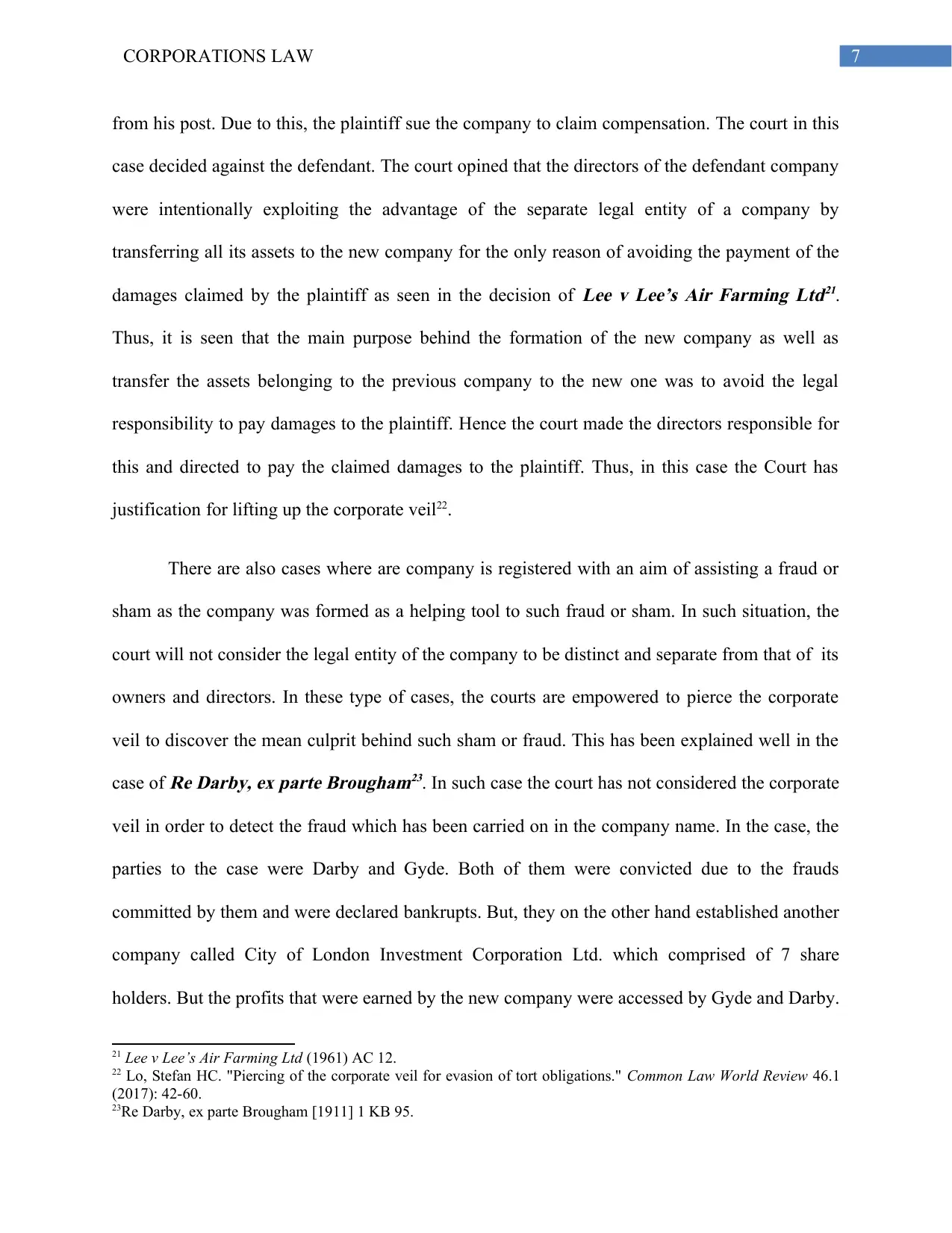
7CORPORATIONS LAW
from his post. Due to this, the plaintiff sue the company to claim compensation. The court in this
case decided against the defendant. The court opined that the directors of the defendant company
were intentionally exploiting the advantage of the separate legal entity of a company by
transferring all its assets to the new company for the only reason of avoiding the payment of the
damages claimed by the plaintiff as seen in the decision of
Lee v Lee’s Air Farming Ltd21.
Thus, it is seen that the main purpose behind the formation of the new company as well as
transfer the assets belonging to the previous company to the new one was to avoid the legal
responsibility to pay damages to the plaintiff. Hence the court made the directors responsible for
this and directed to pay the claimed damages to the plaintiff. Thus, in this case the Court has
justification for lifting up the corporate veil22.
There are also cases where are company is registered with an aim of assisting a fraud or
sham as the company was formed as a helping tool to such fraud or sham. In such situation, the
court will not consider the legal entity of the company to be distinct and separate from that of its
owners and directors. In these type of cases, the courts are empowered to pierce the corporate
veil to discover the mean culprit behind such sham or fraud. This has been explained well in the
case of
Re Darby, ex parte Brougham23. In such case the court has not considered the corporate
veil in order to detect the fraud which has been carried on in the company name. In the case, the
parties to the case were Darby and Gyde. Both of them were convicted due to the frauds
committed by them and were declared bankrupts. But, they on the other hand established another
company called City of London Investment Corporation Ltd. which comprised of 7 share
holders. But the profits that were earned by the new company were accessed by Gyde and Darby.
21 Lee v Lee’s Air Farming Ltd (1961) AC 12.
22 Lo, Stefan HC. "Piercing of the corporate veil for evasion of tort obligations." Common Law World Review 46.1
(2017): 42-60.
23Re Darby, ex parte Brougham [1911] 1 KB 95.
from his post. Due to this, the plaintiff sue the company to claim compensation. The court in this
case decided against the defendant. The court opined that the directors of the defendant company
were intentionally exploiting the advantage of the separate legal entity of a company by
transferring all its assets to the new company for the only reason of avoiding the payment of the
damages claimed by the plaintiff as seen in the decision of
Lee v Lee’s Air Farming Ltd21.
Thus, it is seen that the main purpose behind the formation of the new company as well as
transfer the assets belonging to the previous company to the new one was to avoid the legal
responsibility to pay damages to the plaintiff. Hence the court made the directors responsible for
this and directed to pay the claimed damages to the plaintiff. Thus, in this case the Court has
justification for lifting up the corporate veil22.
There are also cases where are company is registered with an aim of assisting a fraud or
sham as the company was formed as a helping tool to such fraud or sham. In such situation, the
court will not consider the legal entity of the company to be distinct and separate from that of its
owners and directors. In these type of cases, the courts are empowered to pierce the corporate
veil to discover the mean culprit behind such sham or fraud. This has been explained well in the
case of
Re Darby, ex parte Brougham23. In such case the court has not considered the corporate
veil in order to detect the fraud which has been carried on in the company name. In the case, the
parties to the case were Darby and Gyde. Both of them were convicted due to the frauds
committed by them and were declared bankrupts. But, they on the other hand established another
company called City of London Investment Corporation Ltd. which comprised of 7 share
holders. But the profits that were earned by the new company were accessed by Gyde and Darby.
21 Lee v Lee’s Air Farming Ltd (1961) AC 12.
22 Lo, Stefan HC. "Piercing of the corporate veil for evasion of tort obligations." Common Law World Review 46.1
(2017): 42-60.
23Re Darby, ex parte Brougham [1911] 1 KB 95.
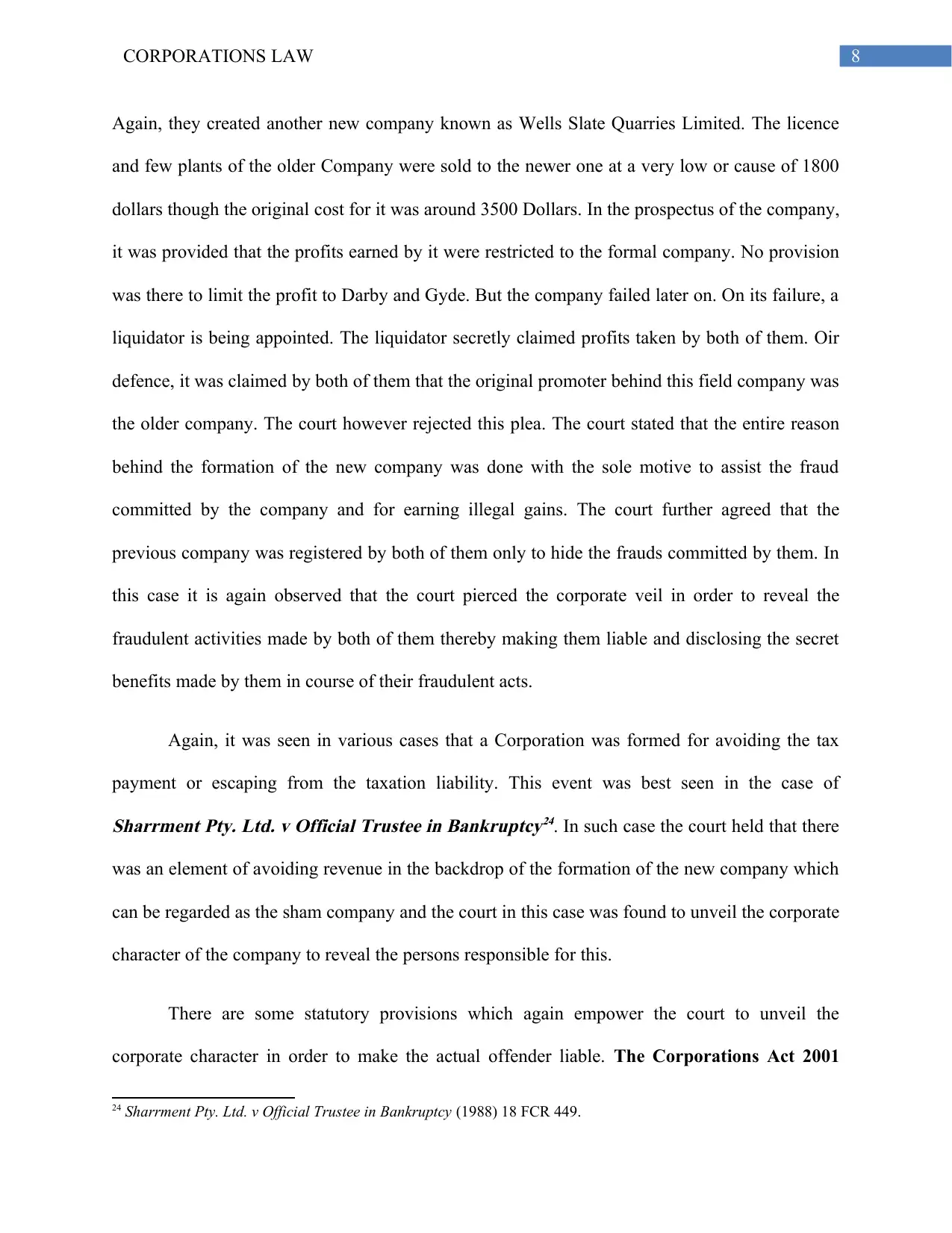
8CORPORATIONS LAW
Again, they created another new company known as Wells Slate Quarries Limited. The licence
and few plants of the older Company were sold to the newer one at a very low or cause of 1800
dollars though the original cost for it was around 3500 Dollars. In the prospectus of the company,
it was provided that the profits earned by it were restricted to the formal company. No provision
was there to limit the profit to Darby and Gyde. But the company failed later on. On its failure, a
liquidator is being appointed. The liquidator secretly claimed profits taken by both of them. Oir
defence, it was claimed by both of them that the original promoter behind this field company was
the older company. The court however rejected this plea. The court stated that the entire reason
behind the formation of the new company was done with the sole motive to assist the fraud
committed by the company and for earning illegal gains. The court further agreed that the
previous company was registered by both of them only to hide the frauds committed by them. In
this case it is again observed that the court pierced the corporate veil in order to reveal the
fraudulent activities made by both of them thereby making them liable and disclosing the secret
benefits made by them in course of their fraudulent acts.
Again, it was seen in various cases that a Corporation was formed for avoiding the tax
payment or escaping from the taxation liability. This event was best seen in the case of
Sharrment Pty. Ltd. v Official Trustee in Bankruptcy24. In such case the court held that there
was an element of avoiding revenue in the backdrop of the formation of the new company which
can be regarded as the sham company and the court in this case was found to unveil the corporate
character of the company to reveal the persons responsible for this.
There are some statutory provisions which again empower the court to unveil the
corporate character in order to make the actual offender liable. The Corporations Act 2001
24 Sharrment Pty. Ltd. v Official Trustee in Bankruptcy (1988) 18 FCR 449.
Again, they created another new company known as Wells Slate Quarries Limited. The licence
and few plants of the older Company were sold to the newer one at a very low or cause of 1800
dollars though the original cost for it was around 3500 Dollars. In the prospectus of the company,
it was provided that the profits earned by it were restricted to the formal company. No provision
was there to limit the profit to Darby and Gyde. But the company failed later on. On its failure, a
liquidator is being appointed. The liquidator secretly claimed profits taken by both of them. Oir
defence, it was claimed by both of them that the original promoter behind this field company was
the older company. The court however rejected this plea. The court stated that the entire reason
behind the formation of the new company was done with the sole motive to assist the fraud
committed by the company and for earning illegal gains. The court further agreed that the
previous company was registered by both of them only to hide the frauds committed by them. In
this case it is again observed that the court pierced the corporate veil in order to reveal the
fraudulent activities made by both of them thereby making them liable and disclosing the secret
benefits made by them in course of their fraudulent acts.
Again, it was seen in various cases that a Corporation was formed for avoiding the tax
payment or escaping from the taxation liability. This event was best seen in the case of
Sharrment Pty. Ltd. v Official Trustee in Bankruptcy24. In such case the court held that there
was an element of avoiding revenue in the backdrop of the formation of the new company which
can be regarded as the sham company and the court in this case was found to unveil the corporate
character of the company to reveal the persons responsible for this.
There are some statutory provisions which again empower the court to unveil the
corporate character in order to make the actual offender liable. The Corporations Act 2001
24 Sharrment Pty. Ltd. v Official Trustee in Bankruptcy (1988) 18 FCR 449.
⊘ This is a preview!⊘
Do you want full access?
Subscribe today to unlock all pages.

Trusted by 1+ million students worldwide
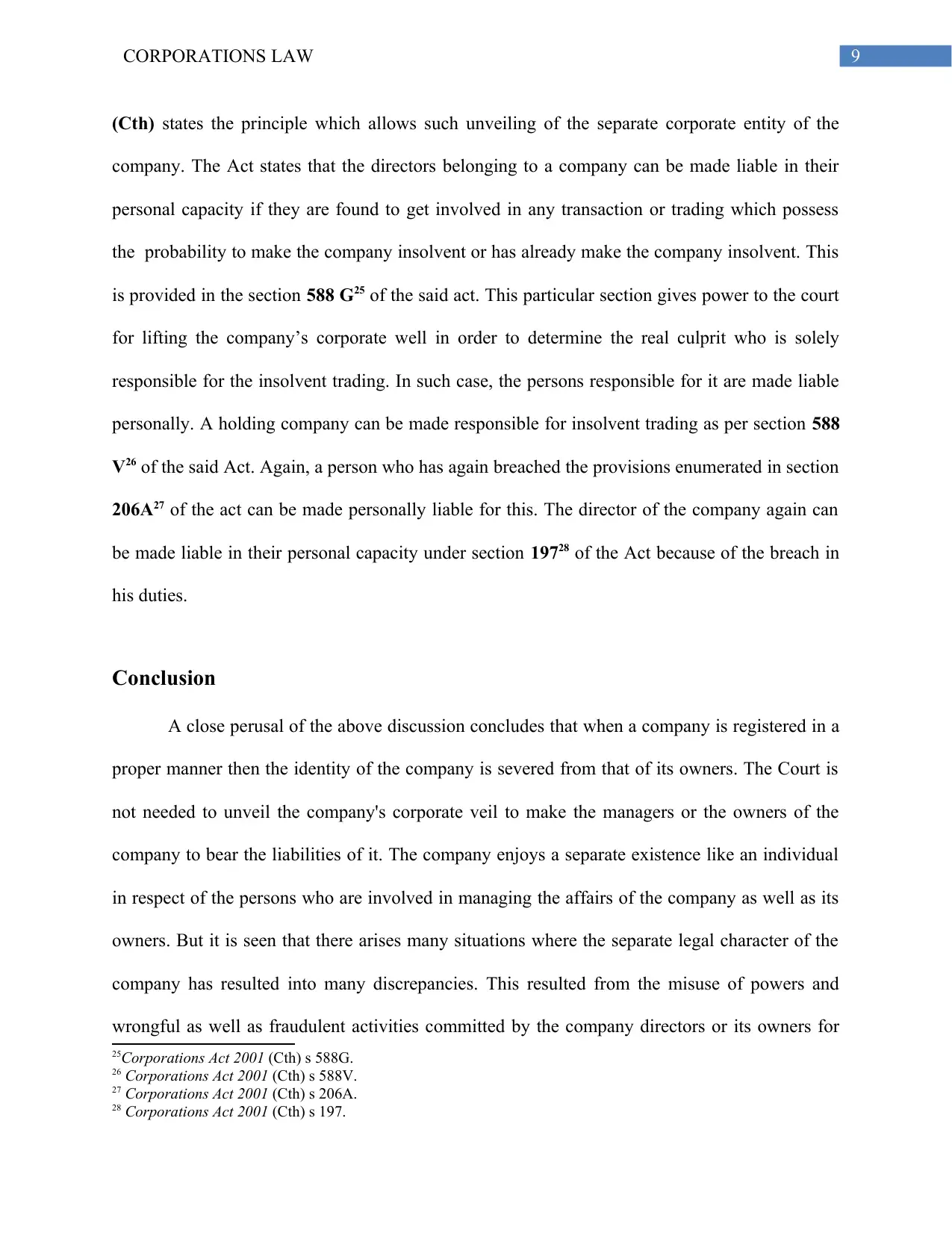
9CORPORATIONS LAW
(Cth) states the principle which allows such unveiling of the separate corporate entity of the
company. The Act states that the directors belonging to a company can be made liable in their
personal capacity if they are found to get involved in any transaction or trading which possess
the probability to make the company insolvent or has already make the company insolvent. This
is provided in the section 588 G25 of the said act. This particular section gives power to the court
for lifting the company’s corporate well in order to determine the real culprit who is solely
responsible for the insolvent trading. In such case, the persons responsible for it are made liable
personally. A holding company can be made responsible for insolvent trading as per section 588
V26 of the said Act. Again, a person who has again breached the provisions enumerated in section
206A27 of the act can be made personally liable for this. The director of the company again can
be made liable in their personal capacity under section 19728 of the Act because of the breach in
his duties.
Conclusion
A close perusal of the above discussion concludes that when a company is registered in a
proper manner then the identity of the company is severed from that of its owners. The Court is
not needed to unveil the company's corporate veil to make the managers or the owners of the
company to bear the liabilities of it. The company enjoys a separate existence like an individual
in respect of the persons who are involved in managing the affairs of the company as well as its
owners. But it is seen that there arises many situations where the separate legal character of the
company has resulted into many discrepancies. This resulted from the misuse of powers and
wrongful as well as fraudulent activities committed by the company directors or its owners for
25Corporations Act 2001 (Cth) s 588G.
26 Corporations Act 2001 (Cth) s 588V.
27 Corporations Act 2001 (Cth) s 206A.
28 Corporations Act 2001 (Cth) s 197.
(Cth) states the principle which allows such unveiling of the separate corporate entity of the
company. The Act states that the directors belonging to a company can be made liable in their
personal capacity if they are found to get involved in any transaction or trading which possess
the probability to make the company insolvent or has already make the company insolvent. This
is provided in the section 588 G25 of the said act. This particular section gives power to the court
for lifting the company’s corporate well in order to determine the real culprit who is solely
responsible for the insolvent trading. In such case, the persons responsible for it are made liable
personally. A holding company can be made responsible for insolvent trading as per section 588
V26 of the said Act. Again, a person who has again breached the provisions enumerated in section
206A27 of the act can be made personally liable for this. The director of the company again can
be made liable in their personal capacity under section 19728 of the Act because of the breach in
his duties.
Conclusion
A close perusal of the above discussion concludes that when a company is registered in a
proper manner then the identity of the company is severed from that of its owners. The Court is
not needed to unveil the company's corporate veil to make the managers or the owners of the
company to bear the liabilities of it. The company enjoys a separate existence like an individual
in respect of the persons who are involved in managing the affairs of the company as well as its
owners. But it is seen that there arises many situations where the separate legal character of the
company has resulted into many discrepancies. This resulted from the misuse of powers and
wrongful as well as fraudulent activities committed by the company directors or its owners for
25Corporations Act 2001 (Cth) s 588G.
26 Corporations Act 2001 (Cth) s 588V.
27 Corporations Act 2001 (Cth) s 206A.
28 Corporations Act 2001 (Cth) s 197.
Paraphrase This Document
Need a fresh take? Get an instant paraphrase of this document with our AI Paraphraser
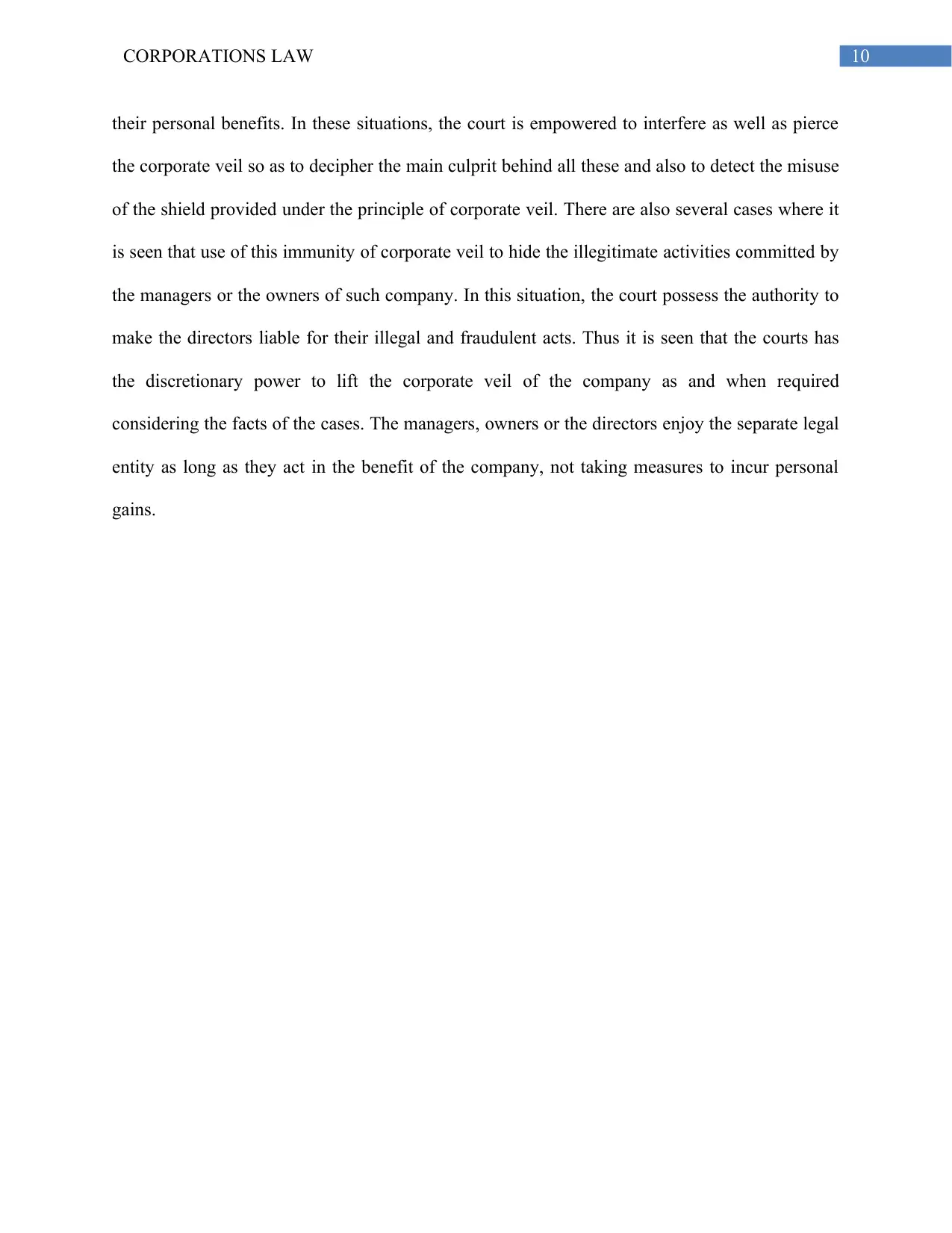
10CORPORATIONS LAW
their personal benefits. In these situations, the court is empowered to interfere as well as pierce
the corporate veil so as to decipher the main culprit behind all these and also to detect the misuse
of the shield provided under the principle of corporate veil. There are also several cases where it
is seen that use of this immunity of corporate veil to hide the illegitimate activities committed by
the managers or the owners of such company. In this situation, the court possess the authority to
make the directors liable for their illegal and fraudulent acts. Thus it is seen that the courts has
the discretionary power to lift the corporate veil of the company as and when required
considering the facts of the cases. The managers, owners or the directors enjoy the separate legal
entity as long as they act in the benefit of the company, not taking measures to incur personal
gains.
their personal benefits. In these situations, the court is empowered to interfere as well as pierce
the corporate veil so as to decipher the main culprit behind all these and also to detect the misuse
of the shield provided under the principle of corporate veil. There are also several cases where it
is seen that use of this immunity of corporate veil to hide the illegitimate activities committed by
the managers or the owners of such company. In this situation, the court possess the authority to
make the directors liable for their illegal and fraudulent acts. Thus it is seen that the courts has
the discretionary power to lift the corporate veil of the company as and when required
considering the facts of the cases. The managers, owners or the directors enjoy the separate legal
entity as long as they act in the benefit of the company, not taking measures to incur personal
gains.
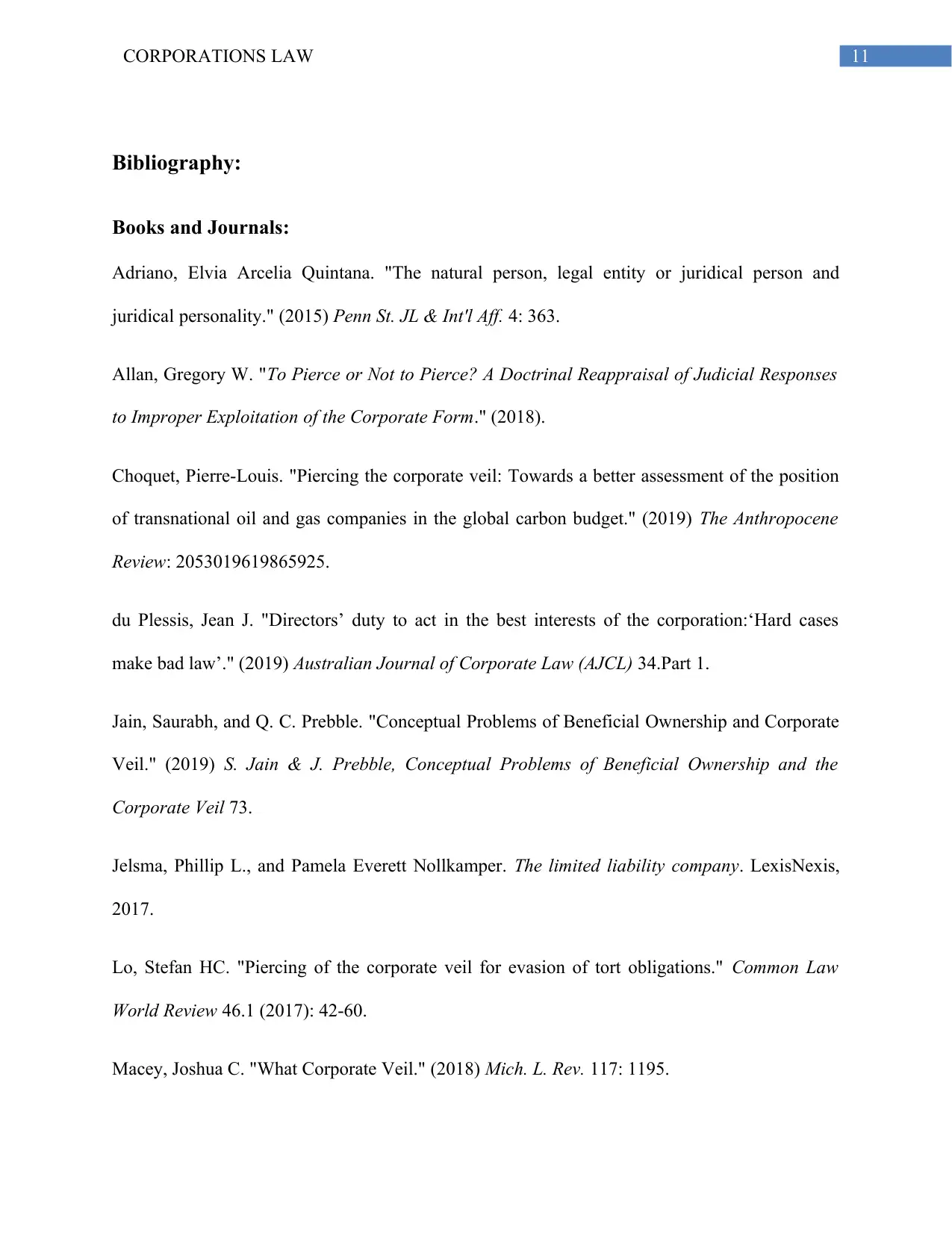
11CORPORATIONS LAW
Bibliography:
Books and Journals:
Adriano, Elvia Arcelia Quintana. "The natural person, legal entity or juridical person and
juridical personality." (2015) Penn St. JL & Int'l Aff. 4: 363.
Allan, Gregory W. "To Pierce or Not to Pierce? A Doctrinal Reappraisal of Judicial Responses
to Improper Exploitation of the Corporate Form." (2018).
Choquet, Pierre-Louis. "Piercing the corporate veil: Towards a better assessment of the position
of transnational oil and gas companies in the global carbon budget." (2019) The Anthropocene
Review: 2053019619865925.
du Plessis, Jean J. "Directors’ duty to act in the best interests of the corporation:‘Hard cases
make bad law’." (2019) Australian Journal of Corporate Law (AJCL) 34.Part 1.
Jain, Saurabh, and Q. C. Prebble. "Conceptual Problems of Beneficial Ownership and Corporate
Veil." (2019) S. Jain & J. Prebble, Conceptual Problems of Beneficial Ownership and the
Corporate Veil 73.
Jelsma, Phillip L., and Pamela Everett Nollkamper. The limited liability company. LexisNexis,
2017.
Lo, Stefan HC. "Piercing of the corporate veil for evasion of tort obligations." Common Law
World Review 46.1 (2017): 42-60.
Macey, Joshua C. "What Corporate Veil." (2018) Mich. L. Rev. 117: 1195.
Bibliography:
Books and Journals:
Adriano, Elvia Arcelia Quintana. "The natural person, legal entity or juridical person and
juridical personality." (2015) Penn St. JL & Int'l Aff. 4: 363.
Allan, Gregory W. "To Pierce or Not to Pierce? A Doctrinal Reappraisal of Judicial Responses
to Improper Exploitation of the Corporate Form." (2018).
Choquet, Pierre-Louis. "Piercing the corporate veil: Towards a better assessment of the position
of transnational oil and gas companies in the global carbon budget." (2019) The Anthropocene
Review: 2053019619865925.
du Plessis, Jean J. "Directors’ duty to act in the best interests of the corporation:‘Hard cases
make bad law’." (2019) Australian Journal of Corporate Law (AJCL) 34.Part 1.
Jain, Saurabh, and Q. C. Prebble. "Conceptual Problems of Beneficial Ownership and Corporate
Veil." (2019) S. Jain & J. Prebble, Conceptual Problems of Beneficial Ownership and the
Corporate Veil 73.
Jelsma, Phillip L., and Pamela Everett Nollkamper. The limited liability company. LexisNexis,
2017.
Lo, Stefan HC. "Piercing of the corporate veil for evasion of tort obligations." Common Law
World Review 46.1 (2017): 42-60.
Macey, Joshua C. "What Corporate Veil." (2018) Mich. L. Rev. 117: 1195.
⊘ This is a preview!⊘
Do you want full access?
Subscribe today to unlock all pages.

Trusted by 1+ million students worldwide
1 out of 14
Related Documents
Your All-in-One AI-Powered Toolkit for Academic Success.
+13062052269
info@desklib.com
Available 24*7 on WhatsApp / Email
![[object Object]](/_next/static/media/star-bottom.7253800d.svg)
Unlock your academic potential
Copyright © 2020–2025 A2Z Services. All Rights Reserved. Developed and managed by ZUCOL.




